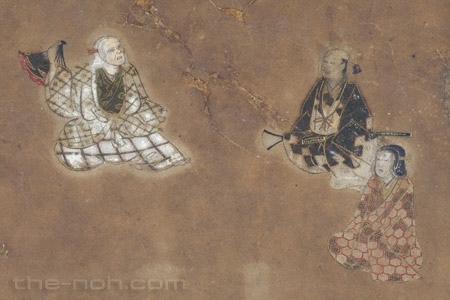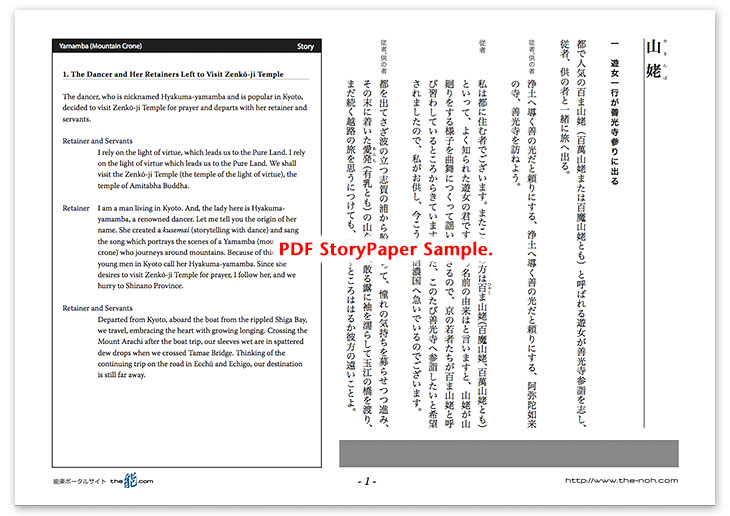
 Yamamba (Mountain Crone)
Yamamba (Mountain Crone)

![]()
A long long time ago, in Kyoto there was a dancer who skillfully created and played a kusemai (storytelling with dance) which portrayed a yamamba (a mountain crone) who journeys around mountains. The song led her to be nicknamed “Hyakuma-yamamba” and it made her popular. One day, she decided to make a pilgrimage to Zenkō-ji Temple and she departed with her retainers to the province of Shinano, where the temple is located. On her way to the temple, she arrived at the village of Sakaigawa, located at the border between the provinces of Ecchū and Echigo. She tried to cross Mount Agero on foot from there; however, all of a sudden, the sun set. Before the dancer’s group who got in trouble, a woman in her late middle-age appeared and offered them a lodge for the night. The woman who invited them to her small house revealed herself as a mountain crone and asked the dancer to recite a phrase of her Yamamba (Mountain Crone) song, which helped enhance the dancer’s reputation by describing the mountain crone herself. The woman further disclosed that she made the sun set faster than usual and invited the group to her house in order to ask the dancer to perform the play. When the frightened dancer tried to recite a part of the play, the woman stopped the dancer and told them that she would reveal her true identity and dance if the dancer recited the play in the middle of the night when the moon rose in the sky. Then, the woman vanished into thin air.
When the night grew old, the dancer and her retainers waited for the mountain crone while playing music. The mountain crone appeared in her anomalous figure. She narrated her days living as a mountain crone in deep mountains and gorges. She preached the profound philosophy of the law of Buddha and performed a dance which showed how a genuine mountain crone rounds mountains. In the meanwhile, the figure of the mountain crone disappeared. She had not been seen anymore.
![]()
Tastefully set deep in the mountains and filled with tense atmosphere, this is a masterpiece of Noh drama. This memorable story weaves together the narrative of two contrasting women, the protagonist in an anomalous shape and the gorgeous dancer. This drama includes, among other themes, a profound discussion on Buddhist philosophy. All of these stylistic and philosophical elements are entwined with each other in this masterpiece.
Although the entire piece gives you a solemn and majestic impression, this is not a quiet and slow drama at all. The scenes changes quickly and the changeful chorus also swiftly shifts its tempo. This piece is visually and aurally impressive; if you get into the story, the development of the breathtaking drama will immediately capture you.
Examining this drama closely, you ask the question to yourself: “What is a mountain crone?” In Japanese fairy tales, a mountain crone is an evil female ogre living somewhere in deep mountains. The mountain crone in this drama, however, does not terrorize people but rather possesses a mystique and nostalgic atmosphere. Her massive presence gives the audience the impression that she is like an incarnation of the universal wisdom of the humans, of the nature, and of the universe. The word Yamamba (mountain crone) is broadly known in Japan and used for describing a woman in a bizarre atmosphere. But no one ever meets a person who claims that they actually saw a real mountain crone. Since the mountains have been developed for business use in modern-day Japan, the dwelling of mountain crones must have already disappeared into thin air. Today, the only place where you can meet the genuine mountain crone, who lives in the unknown, subtle and quiet hermitage, is probably on the Noh stage.
STORY PAPER : Yamamba (Mountain Crone)
Story Paper presents noh chant stories in modern speech, with story outlines, highlights and more using Adobe PDF format, which can print out and zoom in. Print out the pages and take them with you when you see the actual noh performance.

The copyright of Story Paper is held by the Noh.com. Story Paper is for individual use only. It is prohibited by the copyright law to distribute or publish printed-out Story Paper pages without prior consent. For more information, check the credit and disclaimer pages.



 [Yamamba (Mountain Crone) : Story Paper PDF : 548KB
[Yamamba (Mountain Crone) : Story Paper PDF : 548KB